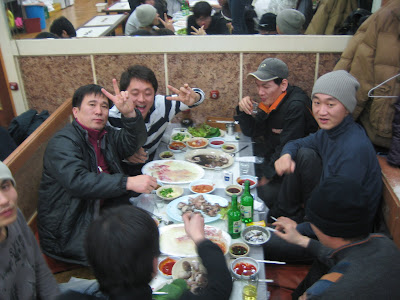 Seoul's largest wholesale fish market, Noryangjin, is located on the southeastern outskirts of Yeouido amid the shadows of the imposing skyscrapers of the capital city's "Manhattan". Follow your nose to the fish market and you'll feel like you've crossed over to the proverbial other side of the tracks. Goodbye glitzy Trump building, hello dingy fish town!
Seoul's largest wholesale fish market, Noryangjin, is located on the southeastern outskirts of Yeouido amid the shadows of the imposing skyscrapers of the capital city's "Manhattan". Follow your nose to the fish market and you'll feel like you've crossed over to the proverbial other side of the tracks. Goodbye glitzy Trump building, hello dingy fish town! 

 Since I paid my visit in the evening, I missed out on the lively, fast-paced market atmosphere. For that, I'd have to hit Noryangjin in the wee hours of the morning when vendors from 700ish individual shops bid on the day's catch. Around 7pm, the market was quieter than I had expected, with retailers surly feeling the fatigue of a long day's work and suited businesspeople looking for some after-work grub. The vinyl-aproned staff of Noryangjin's shops are obviously accustomed to the wide eyes and camera flashes of tourists, and I was surprised by how amenable most vendors were to my particuarly intrusive photo-snapping style.
Since I paid my visit in the evening, I missed out on the lively, fast-paced market atmosphere. For that, I'd have to hit Noryangjin in the wee hours of the morning when vendors from 700ish individual shops bid on the day's catch. Around 7pm, the market was quieter than I had expected, with retailers surly feeling the fatigue of a long day's work and suited businesspeople looking for some after-work grub. The vinyl-aproned staff of Noryangjin's shops are obviously accustomed to the wide eyes and camera flashes of tourists, and I was surprised by how amenable most vendors were to my particuarly intrusive photo-snapping style. 
The wide array of sea life was a bit overwhelming for a novice, and coming from a country where consumers are largely removed from the process of how a creature becomes cuisine, it felt a little strange selecting a live fish to be killed, sliced, and served on the spot. Thankfully, my KBS cohorts were experienced shoppers and hagglers.

One of Noryangjin's greatest features is its adjacent restaurants where you can round out your experience, and your belly, by digging right into your purchase. All the necessary accouterments (soy sauce, wasabi, lettuce, kimchi) are on hand, and restaurant staff begins cooking your fish remnant soup while you get started on the raw fish. It's not fancy, but it was fresh and very economical. My group of six paid about $20 each for as much sashimi, fish soup, seafood pancake (해물파전), and soju we could handle.





